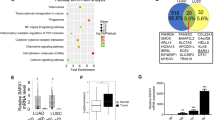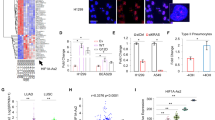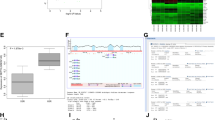Abstract
Transcriptional coactivator with PDZ-binding motif (TAZ) is a transcriptional coactivator involved in the differentiation of stem cell as well as the development of multiple organs. Recently, TAZ has also been identified as a major component of the novel Hippo–LATS tumor suppressor pathway and to function as an oncogene in breast cancer. We show for the first time that TAZ is an oncogene in non-small cell lung cancer (NSCLC). Our results show that TAZ is overexpressed in NSCLC cells and that lentivirus-mediated overexpression of TAZ in HBE135 immortalized human bronchial epithelial cells causes increased cell proliferation and transformation, which can be restored back to its original levels by knockdown of TAZ. In addition, short-hairpin RNA (shRNA)-mediated knockdown of TAZ expression in NSCLC cells suppresses their proliferation and anchorage-independent growth in vitro, and tumor growth in mice in vivo, which can be reversed by re-introduction of shRNA-resistant TAZ into TAZ-knockdown NSCLC cells. These results indicate that TAZ is an oncogene and has an important role in tumorigenicity of NSCLC cells. Therefore, TAZ may present a novel target for the future diagnosis, prognosis and therapy of lung cancer.
This is a preview of subscription content, access via your institution
Access options
Subscribe to this journal
Receive 50 print issues and online access
$259.00 per year
only $5.18 per issue
Buy this article
- Purchase on Springer Link
- Instant access to full article PDF
Prices may be subject to local taxes which are calculated during checkout




Similar content being viewed by others
References
Bass AJ, Watanabe H, Mermel CH, Yu S, Perner S, Verhaak RG et al. (2009). SOX2 is an amplified lineage-survival oncogene in lung and esophageal squamous cell carcinomas. Nat Genet 41: 1238–1242.
Brambilla E, Gazdar A . (2009). Pathogenesis of lung cancer signalling pathways: roadmap for therapies. Eur Respir J 33: 1485–1497.
Cai D, Shames DS, Raso MG, Xie Y, Kim YH, Pollack JR et al. (2010). Steroid receptor coactivator-3 expression in lung cancer and its role in the regulation of cancer cell survival and proliferation. Cancer Res 70: 6477–6485.
Chan SW, Lim CJ, Guo K, Ng CP, Lee I, Hunziker W et al. (2008). A role for TAZ in migration, invasion, and tumorigenesis of breast cancer cells. Cancer Res 68: 2592–2598.
Chow A, Hao Y, Yang X . (2010). Molecular characterization of human homologs of yeast MOB1. Int J Cancer 126: 2079–2089.
Dutt A, Wong KK . (2006). Mouse models of lung cancer. Clin Cancer Res 12: 4396s–44402s.
Hao Y, Chun A, Cheung K, Rashidi B, Yang X . (2008). Tumor suppressor LATS1 is a negative regulator of oncogene YAP. J Biol Chem 283: 5496–5509.
Harvey K, Tapon N . (2007). The salvador-warts-hippo pathway—an emerging tumour-suppressor network. Nat Rev Cancer 7: 182–191.
Hergovich A, Hemmings BA . (2009). Mammalian NDR/LATS protein kinases in hippo tumor suppressor signaling. Biofactors 35: 338–345.
Hong JH, Hwang ES, McManus MT, Amsterdam A, Tian Y, Kalmukova R et al. (2005). TAZ, a transcriptional modulator of mesenchymal stem cell differentiation. Science 309: 1074–1078.
Kim YH, Kwei KA, Girard L, Salari K, Kao J, Pacyna-Gengelbach M et al. (2010). Genomic and functional analysis identifies CRKL as an oncogene amplified in lung cancer. Oncogene 29: 1421–1430.
Lei QY, Zhang H, Zhao B, Zha ZY, Bai F, Pei XH et al. (2008). TAZ promotes cell proliferation and epithelial-mesenchymal transition and is inhibited by the hippo pathway. Mol Cell Biol 28: 2426–2436.
Lo KC, Stein LC, Panzarella JA, Cowell JK, Hawthorn L . (2008). Identification of genes involved in squamous cell carcinoma of the lung using synchronized data from DNA copy number and transcript expression profiling analysis. Lung Cancer 59: 315–331.
Mitani A, Nagase T, Fukuchi K, Aburatani H, Makita R, Kurihara H . (2009). Transcriptional coactivator with PDZ-binding motif is essential for normal alveolarization in mice. Am J Respir Crit Care Med 180: 326–338.
Pan D . (2007). Hippo signaling in organ size control. Genes Dev 21: 886–897.
Sato M, Shames DS, Gazdar AF, Minna JD . (2007). A translational view of the molecular pathogenesis of lung cancer. J Thorac Oncol 2: 327–343.
Sato M, Vaughan MB, Girard L, Peyton M, Lee W, Shames DS et al. (2006). Multiple oncogenic changes (K-RAS(V12), p53 knockdown, mutant EGFRs, p16 bypass, telomerase) are not sufficient to confer a full malignant phenotype on human bronchial epithelial cells. Cancer Res 66: 2116–2128.
Saucedo LJ, Edgar BA . (2007). Filling out the hippo pathway. Nat Rev Mol Cell Biol 8: 613–621.
Sekido Y, Fong KM, Minna JD . (2003). Molecular genetics of lung cancer. Annu Rev Med 54: 73–87.
Strazisar M, Mlakar V, Glavac D . (2009). LATS2 tumour specific mutations and downregulation of the gene in non-small cell carcinoma. Lung Cancer 64: 257–262.
Sun S, Schiller JH, Spinola M, Minna JD . (2007). New molecularly targeted therapies for lung cancer. J Clin Invest 117: 2740–2750.
Tian Y, Kolb R, Hong JH, Carroll J, Li D, You J et al. (2007). TAZ promotes PC2 degradation through a SCFbeta-trcp E3 ligase complex. Mol Cell Biol 27: 6383–6395.
Varelas X, Sakuma R, Samavarchi-Tehrani P, Peerani R, Rao BM, Dembowy J et al. (2008). TAZ controls smad nucleocytoplasmic shuttling and regulates human embryonic stem-cell self-renewal. Nat Cell Biol 10: 837–848.
Visser S, Yang X . (2010). LATS tumor suppressor:a new governor of cellular homeostasis. Cell cycle 9: 3892–3903.
Wang K, Degerny C, Xu M, Yang XJ . (2009). YAP, TAZ, and yorkie: a conserved family of signal-responsive transcriptional coregulators in animal development and human disease. Biochem Cell Biol 87: 77–91.
Wang Y, Dong Q, Zhang Q, Li Z, Wang E, Qiu X . (2010). Overexpression of yes-associated protein contributes to progression and poor prognosis of non-small-cell lung cancer. Cancer Sci 101: 1279–1285.
Wu Y, Zhou BP . (2008). New insights of epithelial-mesenchymal transition in cancer metastasis. Acta Biochim Biophys Sin (Shanghai) 40: 643–650.
Yang X, Li DM, Chen W, Xu T . (2001). Human homologue of Drosophila lats, LATS1, negatively regulate growth by inducing G(2)/M arrest or apoptosis. Oncogene 20: 6516–6523.
Yokota J, Kohno T . (2004). Molecular footprints of human lung cancer progression. Cancer Sci 95: 197–204.
Zeng Q, Hong W . (2008). The emerging role of the hippo pathway in cell contact inhibition, organ size control, and cancer development in mammals. Cancer Cell 13: 188–192.
Zhao B, Lei QY, Guan KL . (2008). The hippo-YAP pathway: new connections between regulation of organ size and cancer. Curr Opin Cell Biol 20: 638–646.
Zhao B, Wei X, Li W, Udan RS, Yang Q, Kim J et al. (2007). Inactivation of YAP oncoprotein by the hippo pathway is involved in cell contact inhibition and tissue growth control. Genes Dev 21: 2747–2761.
Acknowledgements
This work was supported by a grant from the Canadian Institute of Health Research, a grant from the Clinical Trust Fund at Queen's University, a New Investigator Award from the Canadian Institute of Health Research and an Early Researcher Award from the Ontario Ministry of Research and Innovation, Canada to Xiaolong Yang, and a grant from the Canadian Cancer Society (CCSRI-020527) to Ming-Sound Tsao. We thank Dulcie Lai and Stacy Visser for reading the manuscript.
Author information
Authors and Affiliations
Corresponding author
Ethics declarations
Competing interests
The authors declare no conflict of interest.
Rights and permissions
About this article
Cite this article
Zhou, Z., Hao, Y., Liu, N. et al. TAZ is a novel oncogene in non-small cell lung cancer. Oncogene 30, 2181–2186 (2011). https://doi.org/10.1038/onc.2010.606
Received:
Revised:
Accepted:
Published:
Issue Date:
DOI: https://doi.org/10.1038/onc.2010.606
Keywords
This article is cited by
-
TAZ promotes PDX1-mediated insulinogenesis
Cellular and Molecular Life Sciences (2022)
-
LncRNA SFTA1P mediates positive feedback regulation of the Hippo-YAP/TAZ signaling pathway in non-small cell lung cancer
Cell Death Discovery (2021)
-
Isoprenylcysteine carboxylmethyltransferase is required for the impact of mutant KRAS on TAZ protein level and cancer cell self-renewal
Oncogene (2020)
-
The Hippo signaling effector WWTR1 is a metastatic biomarker of gastric cardia adenocarcinoma
Cancer Cell International (2019)
-
Identification of Prolyl isomerase Pin1 as a novel positive regulator of YAP/TAZ in breast cancer cells
Scientific Reports (2019)



